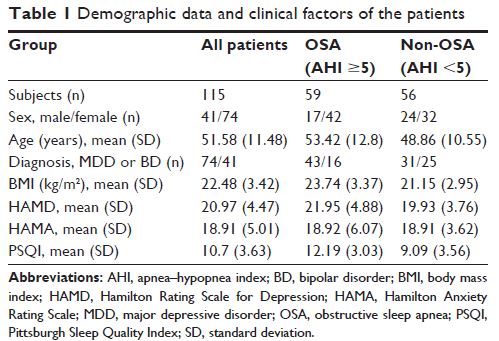9 9 6 5 3
论文已发表
注册即可获取德孚的最新动态
IF 收录期刊
- 3.3 Breast Cancer (Dove Med Press)
- 3.4 Clin Epidemiol
- 2.5 Cancer Manag Res
- 2.9 Infect Drug Resist
- 3.5 Clin Interv Aging
- 4.7 Drug Des Dev Ther
- 2.7 Int J Chronic Obstr
- 6.6 Int J Nanomed
- 2.5 Int J Women's Health
- 2.5 Neuropsych Dis Treat
- 2.7 OncoTargets Ther
- 2.0 Patient Prefer Adher
- 2.3 Ther Clin Risk Manag
- 2.5 J Pain Res
- 2.8 Diabet Metab Synd Ob
- 2.8 Psychol Res Behav Ma
- 3.0 Nat Sci Sleep
- 1.8 Pharmgenomics Pers Med
- 2.7 Risk Manag Healthc Policy
- 4.2 J Inflamm Res
- 2.1 Int J Gen Med
- 4.2 J Hepatocell Carcinoma
- 3.7 J Asthma Allergy
- 1.9 Clin Cosmet Investig Dermatol
- 2.7 J Multidiscip Healthc

抑郁症与阻塞性睡眠呼吸暂停共病患者的风险因素评估
Authors Cai LQ, Xu LY, Wei LL, Sun Y, Chen W
Received 17 September 2016
Accepted for publication 2 December 2016
Published 16 January 2017 Volume 2017:13 Pages 155—159
DOI https://doi.org/10.2147/NDT.S122615
Checked for plagiarism Yes
Review by Single-blind
Peer reviewers approved by Prof. Dr. Roumen Kirov
Peer reviewer comments 2
Editor who approved publication: Professor Wai Kwong Tang
Objective: Overlap of obstructive sleep apnea (OSA) complicates diagnosis of
depressive disorder and renders antidepressant treatment
challenging. Previous studies have reported that the incidence of OSA is higher
in patients with depression than in the general population. The purpose of this
article was to investigate clinical risk factors to predict OSA in depression
disorders.
Methods: A total of 115 patients diagnosed with major
depressive disorder (MDD) and bipolar disorder (in a major depressive episode),
who underwent overnight polysomnography, were studied retrospectively. They
were divided into two groups: non-OSA and OSA. The patients who had
apnea–hypopnea index (AHI) <5 were defined as the non-OSA group, whereas the
OSA group was defined as those with an AHI ≥5. Logistic regression was used to
analyze the association among AHI and clinical factors, including sex, age,
body mass index (BMI), Hamilton Depression Rating Scale (HAMD), Hamilton
Anxiety Rating Scale, Pittsburgh Sleep Quality Index (PSQI), and diagnosis (MDD
or bipolar disorder [in a major depressive episode]).
Results: In 115 patients, 51.3% had OSA. Logistic regression
analysis showed significant associations between AHI and diagnosis (MDD or
bipolar disorder [in a major depressive episode]), BMI, HAMD, and PSQI (P <0.05).
Conclusion: The findings of our study suggested that the rate of
depression being comorbid with OSA is remarkably high and revealed that there
is a high rate of undetected OSA among depressive disorder patients and
untreated OSA among mood disorder patients. The clinical risk factors
(diagnosis [MDD or bipolar disorder {in a major depressive episode}], BMI,
HAMD, and PSQI) could predict AHI or OSA diagnosis and contribute to OSA
screening in depressive disorder patients.
Keywords: major depressive disorder,
polysomnography, obstructive sleep apnea, risk factors, apnea–hypopnea index
